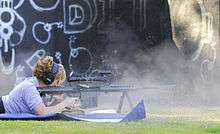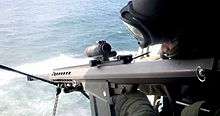Barrett M82
| Barrett M82 | |
|---|---|
|
The M82A1 | |
| Type | Sniper Rifle |
| Place of origin | United States |
| Service history | |
| In service | 1989–present |
| Used by | See Users |
| Wars | |
| Production history | |
| Designer | Ronnie Barrett |
| Designed | 1980 |
| Manufacturer | Barrett Firearms Manufacturing |
| Unit cost |
$12,050 (M82A1)[1] $6,000 (M82A2) |
| Produced | 1982–present |
| Variants |
|
| Specifications | |
| Weight |
M82A1:
|
| Length |
M82A1:
|
| Barrel length |
M82A1:
|
|
| |
| Cartridge | |
| Action | Recoil-operated, rotating bolt |
| Muzzle velocity | 853 m/s (2,799 ft/s) |
| Effective firing range | 1,800 m (1,969 yd) |
| Feed system | 10-round detachable box magazine |
| Sights | Fixed front, adjustable rear sight; MIL-STD-1913 rail provided for optics |
The Barrett M82, standardized by the US Military as the M107, is a recoil-operated, semi-automatic sniper rifle developed by the American Barrett Firearms Manufacturing company. It is used by many units and armies around the world. Despite its designation as an anti-materiel rifle, it is used by some armed forces as an anti-personnel sniper rifle. It is also called the Light Fifty for its .50 BMG (12.7×99mm NATO) chambering and significantly lighter weight compared to previous applications. The weapon is found in two variants, the original M82A1 (and A3) and the bullpup M82A2. The M82A2 is no longer manufactured, though the XM500 can be seen as its successor. This weapon system is recommended for military and law enforcement only as several rifles have failed with fatal results.
Overview
Barrett Firearms Manufacturing was founded by Ronnie Barrett for the sole purpose of building semi-automatic rifles chambered for the powerful 12.7×99mm NATO (.50 BMG) ammunition, originally developed for and used in M2 Browning machine guns. Barrett began his work in the early 1980s, and the first working rifles were available in 1982, hence the designation M82. Barrett designed every single part of the weapon personally and then went on to market the weapon and mass-produce it out of his own pocket. He continued to develop his rifle through the 1980s, and developed the improved M82A1 rifle by 1986.

The first conventional military success was the sale of about 100 M82A1 rifles to the Swedish Army in 1989. Major success followed in 1990, when the United States armed forces purchased significant numbers of the M82A1 during operations Desert Shield and Desert Storm in Kuwait and Iraq. About 125 rifles were initially bought by the United States Marine Corps, and orders from the Army and Air Force soon followed. The M82A1 is known by the US military as the SASR—"Special Applications Scoped Rifle", and it was and still is used as an anti-materiel rifle and explosive ordnance disposal tool. The long effective range, over 1,800 metres (5,900 ft) (1.1 miles), along with high energy and availability of highly effective ammunition such as API and Raufoss Mk 211, allow for effective operations against targets such as radar cabins, trucks, parked aircraft, and the like. The M82 can also be used to defeat human targets from standoff range or against targets behind cover.
Further development led to the M82A2 bullpup rifle in 1987, which was a reduced-recoil design to be fired from the shoulder. It failed to make an impression on the world firearms market, and was soon dropped from production. However, in 2006, Barrett completed development of the XM500, which has a bullpup configuration similar to the M82A2.
The latest derivative of the M82 family is the M82A1M rifle, adopted by U.S. Marine Corps as the M82A3 SASR and bought in large numbers. This rifle differs from M82A1 in that it has a full-length Picatinny rail that allows a wide variety of scopes and sighting devices to be mounted on the rifle. Other changes are the addition of a rear monopod, slightly lightened mechanism, and detachable bipod and muzzle brake.
Another variant of the original weapon is the M82A1A Special Application Scoped Rifle, an almost identical model, but specifically designed to fire the Raufoss Mk 211 Mod 0 round, a type of armor-piercing incendiary ammunition.
Barrett M82 rifles were bought by various military and police forces from at least 30 countries, such as Belgium, Chile, Denmark, Finland, France, Germany, Greece, Italy, Jamaica, Mexico, the Netherlands,[3] Norway, the Philippines, Saudi Arabia, Spain, Sweden, Turkey, the United Kingdom, the United States, and others. The M82 also is widely used for civilian .50 caliber long-range shooting competitions, being fired accurately out to 910 metres (2,990 ft) and even farther.
The United States Coast Guard's Helicopter Interdiction Tactical Squadron and Law Enforcement Detachments use versions of the Barrett M107 to disable the engines of go-fast boats carrying illegal drugs. Barrett M82 rifles have also attracted attention from civilian law enforcement agencies; they have been adopted by the New York City Police Department and the Pittsburgh Police. If it becomes necessary to immobilize a vehicle, a .50 BMG round in the engine block will shut it down quickly. If it is necessary to breach barriers, a .50 BMG round will penetrate most commercial brick walls and concrete blocks.
According to the documentary The Brooklyn Connection, M82s smuggled into Kosovo by sympathizers in the United States quickly became popular long-range sniper rifles in the Kosovo Liberation Army.
The Barrett M82A1 rifle was used in 2002 as a platform for the experimental OSW (Objective Sniper Weapon) prototype. This weapon was fitted with a shorter barrel, and fired 25mm high-explosive shells developed for the 25×59 mm OCSW (Objective Crew Served Weapon) automatic grenade launcher. The experimental OSW showed an increased effectiveness against various targets, but the recoil was beyond human limitations. This weapon, also known as the Barrett "Payload Rifle", has now been designated the XM109.
M82 to M107


The XM107 was originally intended to be a bolt-action sniper rifle, and the rifle Barrett M95 was originally selected by the U.S. Army in a competition between such weapons. However, under the trials, the decision was made that the U.S. Army did not, in fact, require such a weapon.
Then the Army decided on the Barrett M82, a semi-automatic rifle. In summer 2002, the M82 finally emerged from its Army trial phase and was approved for "full materiel release", meaning it was officially adopted as the Long Range Sniper Rifle, Caliber .50, M107. The M107 uses a Leupold 4.5–14×50 Mark 4 scope.
The Barrett M107 is a .50 caliber, shoulder-fired, semi-automatic sniper rifle. Like its predecessors, the rifle is said to have manageable recoil for a weapon of its size owing to the barrel assembly that itself absorbs force, moving inward toward the receiver against large springs with every shot. Additionally, the weapon's weight and large muzzle brake also assist in recoil reduction. Various changes were made to the original M82A1 to create the M107, with new features such as a lengthened accessory rail, rear grip, and monopod socket. Barrett has recently been asked to develop a lightweight version of the M107 under the Anti-Materiel Sniper Rifle Congressional Program, and has already come up with a scheme to build important component parts such as the receiver frame and muzzle brake out of lighter-weight materials.
The Barrett M107, like previous members of the M82 line, is also referred to as the Barrett "Light Fifty". The designation has in many instances supplanted earlier ones, with the M107 being voted one of 2005's top 10 military inventions by the U.S. Army.[4]
Barrett M107CQ
A commercial development of the "new" M107, the M107CQ is specifically designed where the firepower of a .50 caliber rifle is required, but the bulk of the M82/M107 series prevents the weapon from being used. The M107CQ is 9 inches shorter in overall length (all in the barrel) and 5 lb lighter than the M107. According to the manufacturer, the M107CQ is suitable for use in helicopters, force protection watercraft, tactical scout land vehicles, and as an urban soldier's combat multiplier for close-quarters battles.[5]
Barrett M107A1
In October 2010, Barrett unofficially reported production of the M107 had ceased, and in January 2011, the company announced that its successor, the M107A1, was available for commercial release. Significant enhancements include a reduction in weight of 5 lb, a new cylindrical titanium muzzle brake and titanium barrel key/recoil buffer system which allows the weapon to operate with a Barrett-designed suppressor, and other functional modifications that increase durability and operator utility.[6]
Technical description



The M82 is a short-recoil semi-automatic firearm. When the gun is fired, the barrel initially recoils for a short distance (about 1 in (25 mm)), while being securely locked by the rotating bolt. After the short travel, a post on the bolt engaged in the curved cam track in the receiver turns the bolt to unlock it from the barrel. As soon as the bolt unlocks, the accelerator arm strikes it back, transferring part of the recoil energy of the barrel to the bolt to achieve reliable cycling. Then, the barrel is stopped and the bolt continues back, to extract and eject a spent case. On its return stroke, the bolt strips the fresh cartridge from the box magazine and feeds it into the chamber and finally locks itself to the barrel. The striker is also cocked on the return stroke of the bolt. The gun is fed from a large, detachable box magazine holding up to 10 rounds, although a rare 12-round magazine was developed for use during Operation Desert Storm in 1991.
The receiver is made from two parts (upper and lower), stamped from sheet steel and connected by cross-pins. The heavy barrel is fluted to improve heat dissipation and save weight, and fitted with a large and effective reactive muzzle brake. On the earlier models, the muzzle brakes had a round cross-section; later M82 rifles are equipped with two-chamber brakes of rectangular cross-section.
M82A1 rifles are fitted with scope mount and folding backup iron sights, should the glass scope break. The U.S. military M82 rifles are often equipped with Leupold Mark 4 telescopic sights. The M82A1M (USMC M82A3) rifles have long Picatinny accessory rails mounted and US Optics telescopic sights. Every M82 rifle is equipped with a folding carrying handle and a folding bipod (both are detachable on the M82A3). The M82A3 is also fitted with a detachable rear monopod under the butt. The buttpad is fitted with a soft recoil pad to further decrease the felt recoil. M82A1 and M82A3 rifles could be mounted on the M3 or M122 infantry tripods (originally intended for machine guns) or on vehicles using the special Barrett soft-mount. The M82A1 can be fitted with a carry sling, but according to those who carried it in the field, the M82 is too uncomfortable to be carried on a sling due to its excessive length and weight. It is usually carried in a special carry soft or hard case.
The M82A2 differed from M82A1 mostly in its configuration; the pistol grip along with trigger was placed ahead of the magazine, and the buttpad placed below the receiver, just after the magazine. An additional forward grip was added below the receiver, and the scope mount was moved forward.
The maximum effective range of the M107 is 1,830 metres (2,000 yd). The maximum range of this weapon (specifically the M107 variant) is 4,000 metres (4,400 yd), as quoted in the owner's manual. Fifty caliber (and larger) rounds have the potential to travel great distances if fired in an artillery-like fashion, necessitating the observance of large safety margins when firing on a range.
Users



-
 Argentina: Argentine Army, Argentine Marines
Argentina: Argentine Army, Argentine Marines -
 Armenia
Armenia -
 Australia: Special Operations Command in Afghanistan.[8]
Australia: Special Operations Command in Afghanistan.[8] -
 Austria: Used by Austrian Army SF Jagdkommando.[9]
Austria: Used by Austrian Army SF Jagdkommando.[9] -
 Bahrain[10]
Bahrain[10] -
.svg.png) Belgium[10]
Belgium[10] -
 Bhutan[10]
Bhutan[10] -
 Botswana[10]
Botswana[10] -
 Brazil[10]
Brazil[10] -
 Canada: Used by the Peel Regional Police
Canada: Used by the Peel Regional Police -
 Chile[10]
Chile[10] -
 Czech Republic[10][11]
Czech Republic[10][11] -
 Denmark[10]
Denmark[10] -
 Dominican Republic
Dominican Republic -
 Egypt: Used by Egyptian Special Operations Forces.
Egypt: Used by Egyptian Special Operations Forces. -
 El Salvador[10]
El Salvador[10] -
 Finland[10]
Finland[10] -
 France[10] Used by GIGN (before PGM Hécate II)
France[10] Used by GIGN (before PGM Hécate II) -
 Georgia: Used by Georgian Armed Forces and Georgian special forces.[12][13]
Georgia: Used by Georgian Armed Forces and Georgian special forces.[12][13] -
 Germany: The M107 is used and designated G82 in the German Army and the M107A1 is used under the designation G82A1.[14]
Germany: The M107 is used and designated G82 in the German Army and the M107A1 is used under the designation G82A1.[14] -
 Greece[10]
Greece[10] -
 India: The M107 is used by Mumbai Police Force One Commandos.[15]
India: The M107 is used by Mumbai Police Force One Commandos.[15] -
 Iraq: Used by Iraqi Special Operations Forces
Iraq: Used by Iraqi Special Operations Forces -
 Israel: Used by the IDF Combat Engineering Corps[16]
Israel: Used by the IDF Combat Engineering Corps[16] -
 Italy[10]
Italy[10] -
 Japan: Used by the Special Forces Group.[17]
Japan: Used by the Special Forces Group.[17] -
 Jordan[10][18]
Jordan[10][18] -
 Kuwait[10]
Kuwait[10] -
 Lebanon[19] The Barett is mostly used by the Lebanese Commando Regiment and the Internal Security Forces.
Lebanon[19] The Barett is mostly used by the Lebanese Commando Regiment and the Internal Security Forces. -
 Lithuania: Lithuanian Armed Forces.[20]
Lithuania: Lithuanian Armed Forces.[20] -
 Malaysia: Malaysian Special Operations Force.[21]
Malaysia: Malaysian Special Operations Force.[21] -
 Mauritius: Military of Mauritius
Mauritius: Military of Mauritius -
 Mexico[10]
Mexico[10] -
 Netherlands[10]
Netherlands[10]

-
 Norway[10]
Norway[10] -
 Oman[10]
Oman[10] -
 Philippines[10]Armed Forces of the Philippines, Philippine National Police
Philippines[10]Armed Forces of the Philippines, Philippine National Police -
 Poland: Wojska Specjalne
Poland: Wojska Specjalne -
 Portugal[10]
Portugal[10] -
 Qatar[10]
Qatar[10] -
 Romania: Used by the special forces of Romanian Armed Forces.
Romania: Used by the special forces of Romanian Armed Forces. -
 Saudi Arabia[10]
Saudi Arabia[10] -
 Singapore[10]
Singapore[10] -
 Spain[10]
Spain[10] -
 Sweden: Used as Ag 90 C.[10]
Sweden: Used as Ag 90 C.[10] -
 South Korea[22]
South Korea[22] -
 Thailand: Used by Royal Thai Navy SEALs.
Thailand: Used by Royal Thai Navy SEALs. -
 Tunisia: Used by Unité Spéciale Garde Nationale (USGN) and Groupe des Forces Spéciales (GFS).
Tunisia: Used by Unité Spéciale Garde Nationale (USGN) and Groupe des Forces Spéciales (GFS). -
 Turkey[10]
Turkey[10] -
 Pakistan: Used by the Pakistan Army.[23]
Pakistan: Used by the Pakistan Army.[23] -
 Republic of China[24]
Republic of China[24] -
 Ukraine: Used by the Ukrainian Army.[25][26][27][28]
Ukraine: Used by the Ukrainian Army.[25][26][27][28] -
 United Arab Emirates[10]
United Arab Emirates[10] -
 United Kingdom[10]
United Kingdom[10] -
 United States[10]
United States[10]
U.S. designation summary
- M82: 12.7×99mm Barrett M82 semi-automatic rifle.
- M82A1: 12.7×99mm Barrett M82A1 semi-automatic rifle. Improved variant including redesigned muzzle brake.
- M82A1A: 12.7×99mm Barrett M82A1 semi-automatic rifle variant. Optimized for use with the Mk 211 Mod 0 .50 caliber round.
- M82A1M: 12.7×99mm Barrett M82A1 semi-automatic rifle variant. Improved variant including lengthened accessory rail. Includes rear grip and monopod socket.
- M82A2: 12.7×99mm Barrett M82A2 semi-automatic rifle. Bullpup configuration.
- M82A3: 12.7×99mm Barrett M82A3 semi-automatic rifle. New production rifles built to M82A1M specifications, featuring lengthened accessory rail which is usually, but not always, raised higher up than the M82A1M/M107. Unlike the M82A1M/M107, it does not include rear grip and monopod socket.
- XM107/M107: Initially used to designate 12.7×99mm Barrett M95 bolt-action rifle. Designation changed to apply to a product improved M82A1M variant. Includes lengthened accessory rail, rear grip, and monopod socket.
- M107A1: 12.7×99mm Barrett M107A1 semi-automatic rifle. Improved variant of M107/M82. Features stronger construction with a 4 lb reduction in overall weight. Includes a retractable monopod, redesigned stock, thermal-guard cheek-piece, and a four-port muzzle brake designed for use with a sound/flash suppressor.
Specifications
M82A1
- Caliber: .50 BMG (12.7×99mm) and .416 Barrett (10.6×83mm)[29]
- Operation: short recoil, semi-automatic
- Overall length: 57 inches (145 cm) w/ 29 inch (73.7 cm) barrel or 48 inches (122 cm) w/ 20 inch (50.8 cm) barrel
- Barrel length: 508 millimetres (20.0 in) or 737 mm (29.0 in)
- Feed device: 10-round detachable box magazine
- Sights: Flip up, optics vary by user preference
- Weight: 30.9 lb (14.0 kg) w/ 29 inch (73.7 cm) barrel or 29.7 lb (13.5 kg) w/ 20 inch (50.8 cm) barrel
- Muzzle velocity with 660 grain, 42.8 g projectile: 853 m/s (2,800 ft/s) with 400 grain, 26.0 g solid brass projectile: 990 m/s (3,200 ft/s)
- Effective range: 1,800 m (5,900 ft)
- Maximum Range: 6,812 m (22,349 ft)[30]
- Expected accuracy: Sub-MOA with match ammo
- Unit replacement cost: $8,900 US
M82A2
- Caliber: .50 BMG (12.7×99mm)
- Length: 1,409 mm (55.5 in)
- Barrel length: 737 mm (29.0 in)
- Weight (unloaded): 14.75 kg (32.5 lb)
- Effective range on equipment-sized targets: 2,000 m (6,600 ft)
- Muzzle velocity: 900 m/s (3,000 ft/s)
- Magazine capacity: 10 rounds
- Unit replacement cost: $6,000
- Status: Prototype seeing combat in Iraq
M107
- Caliber: .50 BMG (12.7×99mm)
- Length: 1,448 mm (57.0 in)
- Barrel length: 737 mm (29.0 in)
- Weight (unloaded w/ scope): 12.9 kg (28.4 lb)
- Magazine capacity: 11 rounds
- Weight of magazine: 1.87 kg (4.1 lb)
- Accuracy: 3 Minutes of Angle (MOA)
- Muzzle velocity: 853 m/s (2,800 ft/s)
- Effective Range: 1,829 m (6,001 ft)[30]
- Maximum Range: 6,812 m (22,349 ft)[30]
XM500
- Bullpup
- Caliber: .50 BMG (12.7×99mm)
- Length: 1,168 millimetres (46.0 in)
- Operation: gas operated, semi-automatic
- Barrel: 447 millimetres (17.6 in)
- Weight: 11.8 kg (26.0 lb)
- Feed device: 10-round detachable box magazine
Awards and Recognition
On February 26, 2016, Tennessee named the Barrett Model M82 as its official state rifle.[31][32][33][34]
See also
- Accuracy International AS50
- Raufoss Mk 211 round
- Barrett M90
- Barrett M95
- Boys anti-tank rifle, a World War II predecessor
- CheyTac Intervention
- MACS M3
- Denel NTW-20
- DSR-50
- PDSHP
- Istiglal anti-materiel rifle
- KSVK 12.7
- List of crew served weapons of the US Armed Forces
- List of individual weapons of the U.S. Armed Forces
- PGM Hécate II
- M24
- McMillan Tac-50
- OSV-96, a Russian counterpart
- RT-20 (rifle)
- South Armagh Sniper (1990–97)
- Steyr HS .50
References
- ↑ http://www.barrettrifles.com/rifle_82.aspx Barrett Rifles
- ↑ http://ww2.gun-world.net/usa/barrett/m82/m82a1cq.htm Barrett M82A1 CQ
- ↑ The weapon is in use by Dutch marines, as part of ISAF. Bemmel, Noël van (2009-08-11). "Met aangepaste Vikings en een reuzengeweer de Chora-vallei in". de Volkskrant. Retrieved 2009-08-13.
- ↑ Police Precision Rifle Press Releases Archived October 14, 2007, at the Wayback Machine..
- ↑ Barrett Rifles Archived March 13, 2008, at the Wayback Machine..
- ↑ Archived January 23, 2011, at the Wayback Machine..
- ↑ "Telescopic Sights 6–24 x 56; 6–24 x 72" (PDF). Carl Zeiss Optronics. Carl Zeiss AG. Archived from the original (PDF) on 2008-10-31.
- ↑ http://www.defence.gov.au/op/afghanistan/gallery/2010/20101105
- ↑ http://www.doppeladler.com/da/oebh/50-jahre-jagdkommando/
- 1 2 3 4 5 6 7 8 9 10 11 12 13 14 15 16 17 18 19 20 21 22 23 24 25 26 27 28 29 30 Gander, Terry (2006). Jane's Infantry Weapons 2006–2007. London: Jane's Information Group. p. 22. ISBN 0-7106-2755-6.
- ↑ Ruční Zbraně AČR (Czech). Ministerstvo obrany České republiky – AVIS, 2007. pp. 70–73. ISBN 978-80-7278-388-5. Accessed April 5, 2010.
- ↑ Disarmament.un.org
- ↑ "Georgian Army". Georgian Army. Archived from the original on 2012-03-09. Retrieved 2007-06-25.
- ↑ Redaktion Heer. Scharfschützengewehr G82 Archived February 17, 2010, at the Wayback Machine. (German). Deutsches Heer, 30 July 2007. Accessed April 5, 2010.
- ↑ Swami, Praveen (April 8, 2009). "Mumbai Police modernisation generates controversy". The Hindu. p. 1 ("front page"). Retrieved April 5, 2010.
- ↑ The Engineering Corps Prepares for 2011 Archived January 28, 2011, at the Wayback Machine.. IDF Spokesperson, 25 January 2011.
- ↑ http://news.ifeng.com/a/20150126/43023401_0.shtml#p=6
- ↑ Shea, Dan (Spring 2009). "SOFEX 2008". Small Arms Defense Journal, p. 29.
- ↑ Kahwaji, Riad (November 13, 2007). "Lebanon: Foreign Arms Vital to Hizbollah Fight". Defense News. Check date values in:
|year= / |date= mismatch(help) - ↑ "Stambaus kalibro snaiperio šautuvas BARRETT 82 A-1" (in Lithuanian). Lithuanian Armed Forces. Archived from the original on 28 July 2010. Retrieved August 2, 2010.
- ↑ Thompson, Leroy (December 2008). "Malaysian Special Forces". Special Weapons. Retrieved 2010-02-10.
- ↑ http://bemil.chosun.com/nbrd/bbs/view.html?b_bbs_id=10067&pn=1&num=745
- ↑ "Pakistan Army". Archived from the original on 2013-10-12.
- ↑ https://www.youtube.com/watch?v=_ApRSG5UTmQ
- ↑ "Новости Украины Twitter".
- ↑ https://twitter.com/banderenko/status/573853604077006849
- ↑ https://twitter.com/banderenko/status/572848500792303617
- ↑ https://twitter.com/banderenko/status/574976556038230016
- ↑ New product offered by Barrett Arms Co. (www.barrettfirearms.com)
- 1 2 3 Cooke, Gary W. "M107 .50 Caliber Long Range Sniper Rifle (LRSR)". Gary's U.S. Infantry Weapons Reference Guide. Gary's Place. Archived from the original on 25 April 2009. Retrieved 2009-05-01.
- ↑ Van Huss, James (Micah) (February 26, 2016). "HJR0231" (PDF). Tennessee General Assembly.
- ↑ Stockard, Sam (24 February 2016). "Rutherford County home to official state firearm". The Murfreesboro Post. Murfreesboro, Tennessee. Retrieved 12 March 2016.
The Barrett .50 resolution passed the House in 2015 sponsored by Rep. Micah Van Huss, R-Johnson City, a former Marine who carried it while serving in Iraq from 2006 to 2010.
- ↑ Sher, Andy (24 February 2016). "Tennessee names the Barrett .50 caliber as the state's official rifle". Chattanooga Times Free Press. Retrieved 12 March 2016.
Senate Democratic Caucus Chairman Jeff Yarbro of Nashville cast the lone dissenting vote against making the Barrett rifle the state's official gun.
- ↑ Smith, Aaron (26 February 2016). "Tennessee names .50 caliber Barrett as the state rifle". CNNMoney. Retrieved 12 March 2016.
External links
| Wikimedia Commons has media related to M82 (rifle). |
- Barrett's page on the M82A1
- M82A1 Operators Manual
- PEO Soldier M107 fact sheet
- Detailed M107 page including gallery
- M107A1 Sales Sheet
- Globalsecurity.com M82 info with video of effects on steel plating and cinder blocks
- The Barrett M82 from Mel's SniperCentral
- Modern Firearms, XM500 info
- M82 Info from Armedforces-int.com



